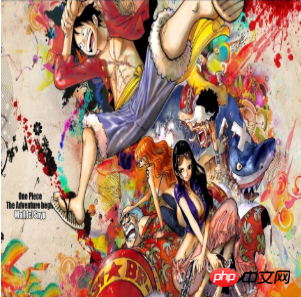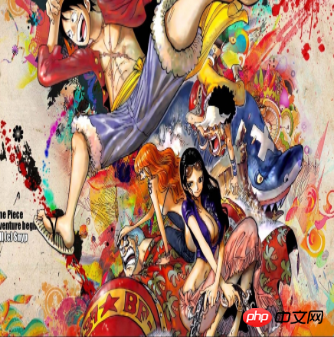How to enlarge the image by placing the mouse in css3? (with code)
In the study of css3, we will often make some small animation effects, which is very interesting, so today’s article will introduce to you an effect of css3 to achieve image amplification. Interested friends can take a look.
We all know that CSS3 adds a transform attribute that applies to 2D or 3D transformation of elements. The transform attribute allows us to rotate, scale, move or tilt elements. Therefore, the transform attribute is needed to achieve image enlargement in css3. Let's take a look at the effect of using the transform attribute in css3 to achieve image enlargement.
The first type: css3 realizes the effect that when we put the mouse on the picture, the picture is enlarged and the excess part is not hidden:
<!DOCTYPE html>
<html>
<head>
<meta charset="UTF-8">
<title></title>
<style type="text/css">
.enlarge{
width: 300px;
height: 300px;
border: 1px #ffffff solid;
}
.enlarge img{
width: 100%;
height: 100%;
cursor: pointer;
transition: all 0.6s;
-ms-transition: all 0.8s;
}
.enlarge img:hover{
transform: scale(1.2);
-ms-transform: scale(1.2);
}
</style>
</head>
<body>
<div class="enlarge">
<img src="/static/imghw/default1.png" data-src="images/tu.jpg" class="lazy" alt="图片"/>
</div>
</body>
</html>css3 The comparison before and after the effect of placing the mouse on the picture to enlarge the picture is as follows: The effect of enlarging the picture and hiding the part beyond it:
<!DOCTYPE html>
<html>
<head>
<meta charset="UTF-8">
<title></title>
<style type="text/css">
.enlarge{
width: 300px;
height: 300px;
overflow: hidden;
border: 1px #ffffff solid;
}
.enlarge img{
width: 100%;
height: 100%;
cursor: pointer;
transition: all 0.6s;
-ms-transition: all 0.8s;
}
.enlarge img:hover{
transform: scale(1.3);
-ms-transform: scale(1.3);
}
</style>
</head>
<body>
<div class="enlarge">
<img src="/static/imghw/default1.png" data-src="images/tu.jpg" class="lazy" alt="图片"/>
</div>
</body>
</html> css3 The before and after effect of placing the mouse on the picture to enlarge is as follows:
css3 The before and after effect of placing the mouse on the picture to enlarge is as follows: 
## Note: For the above two situations of enlarging images using css3, the :hover pseudo-class is used, which represents the state when the mouse is hovering, so that when we put the mouse on the image, it will Let the picture be enlarged, and when the mouse is removed, the picture will return to its original size.
The above is the entire content of this article. For more detailed usage of the transform attribute in css3, you can refer to css3 Learning Manual for further understanding.
The above is the detailed content of How to enlarge the image by placing the mouse in css3? (with code). For more information, please follow other related articles on the PHP Chinese website!

Hot AI Tools

Undresser.AI Undress
AI-powered app for creating realistic nude photos

AI Clothes Remover
Online AI tool for removing clothes from photos.

Undress AI Tool
Undress images for free

Clothoff.io
AI clothes remover

AI Hentai Generator
Generate AI Hentai for free.

Hot Article

Hot Tools

Notepad++7.3.1
Easy-to-use and free code editor

SublimeText3 Chinese version
Chinese version, very easy to use

Zend Studio 13.0.1
Powerful PHP integrated development environment

Dreamweaver CS6
Visual web development tools

SublimeText3 Mac version
God-level code editing software (SublimeText3)

Hot Topics
 How to achieve wave effect with pure CSS3? (code example)
Jun 28, 2022 pm 01:39 PM
How to achieve wave effect with pure CSS3? (code example)
Jun 28, 2022 pm 01:39 PM
How to achieve wave effect with pure CSS3? This article will introduce to you how to use SVG and CSS animation to create wave effects. I hope it will be helpful to you!
 Use CSS skillfully to realize various strange-shaped buttons (with code)
Jul 19, 2022 am 11:28 AM
Use CSS skillfully to realize various strange-shaped buttons (with code)
Jul 19, 2022 am 11:28 AM
This article will show you how to use CSS to easily realize various weird-shaped buttons that appear frequently. I hope it will be helpful to you!
 How to hide elements in css without taking up space
Jun 01, 2022 pm 07:15 PM
How to hide elements in css without taking up space
Jun 01, 2022 pm 07:15 PM
Two methods: 1. Using the display attribute, just add the "display:none;" style to the element. 2. Use the position and top attributes to set the absolute positioning of the element to hide the element. Just add the "position:absolute;top:-9999px;" style to the element.
 How to implement lace borders in css3
Sep 16, 2022 pm 07:11 PM
How to implement lace borders in css3
Sep 16, 2022 pm 07:11 PM
In CSS, you can use the border-image attribute to achieve a lace border. The border-image attribute can use images to create borders, that is, add a background image to the border. You only need to specify the background image as a lace style; the syntax "border-image: url (image path) offsets the image border width inward. Whether outset is repeated;".
 It turns out that text carousel and image carousel can also be realized using pure CSS!
Jun 10, 2022 pm 01:00 PM
It turns out that text carousel and image carousel can also be realized using pure CSS!
Jun 10, 2022 pm 01:00 PM
How to create text carousel and image carousel? The first thing everyone thinks of is whether to use js. In fact, text carousel and image carousel can also be realized using pure CSS. Let’s take a look at the implementation method. I hope it will be helpful to everyone!
 How to enlarge the image by clicking the mouse in css3
Apr 25, 2022 pm 04:52 PM
How to enlarge the image by clicking the mouse in css3
Apr 25, 2022 pm 04:52 PM
Implementation method: 1. Use the ":active" selector to select the state of the mouse click on the picture; 2. Use the transform attribute and scale() function to achieve the picture magnification effect, the syntax "img:active {transform: scale(x-axis magnification, y Axis magnification);}".
 How to implement mouse-over magnification effect on images with JavaScript?
Oct 20, 2023 am 09:16 AM
How to implement mouse-over magnification effect on images with JavaScript?
Oct 20, 2023 am 09:16 AM
How to implement mouse-over magnification effect on images with JavaScript? Today's web design pays more and more attention to user experience, and many web pages add some special effects to pictures. Among them, the picture mouse-over magnification effect is a common special effect, which can automatically enlarge the picture when the user hovers the mouse, increasing the interaction between the user and the picture. This article will introduce how to use JavaScript to achieve this effect and give specific code examples. Idea analysis: To achieve the mouse-over magnification effect of images, we can use JavaS
 css3 what is adaptive layout
Jun 02, 2022 pm 12:05 PM
css3 what is adaptive layout
Jun 02, 2022 pm 12:05 PM
Adaptive layout, also known as "responsive layout", refers to a web page layout that can automatically recognize the screen width and make corresponding adjustments; such a web page can be compatible with multiple different terminals instead of making a specific version for each terminal. . Adaptive layout was born to solve the problem of mobile web browsing, and can provide a good user experience for users using different terminals.






